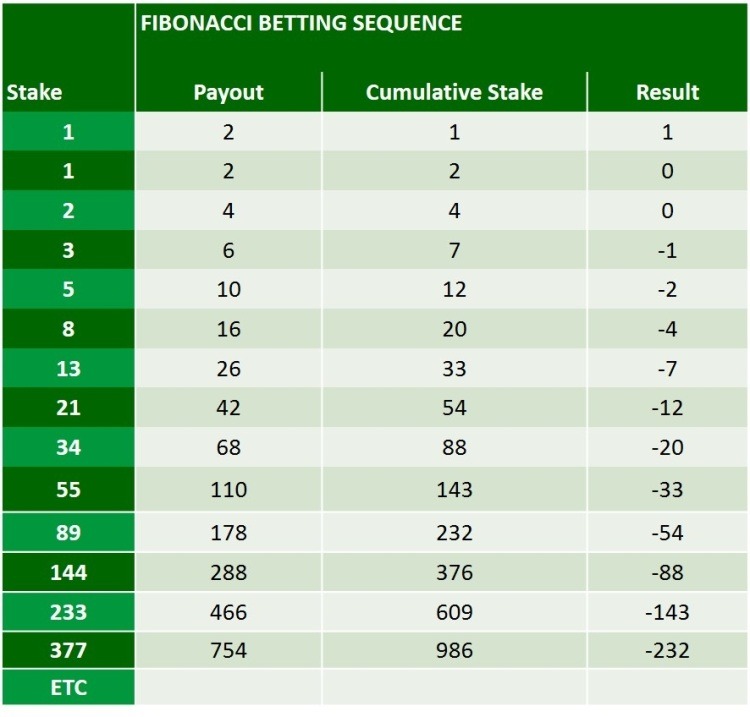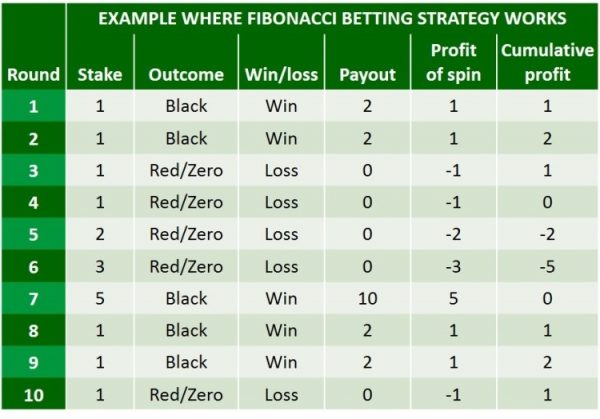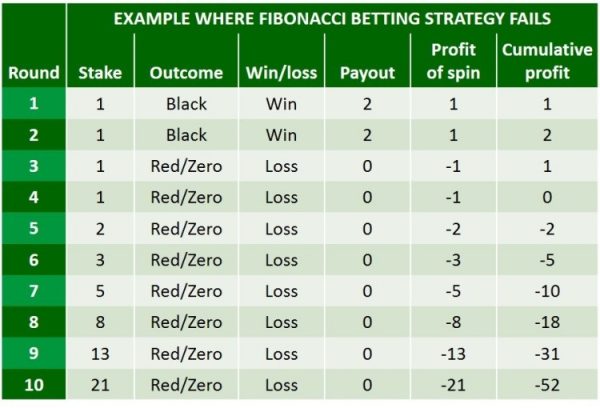The Fibonacci strategy finds its origins in the famous Fibonacci sequence
You probably have seen it at school.
In this sequence, every next number is the sum of the two previous numbers in the series. It applies for ‘even’ bets, so betting on Red-Black, Odd-Even or 1-18/19-36 at roulette or betting Punto or Banco at baccarat.
In the Fibonacci strategy, the sequence is as follows:
1-1-2-3-5-8-13-21-34-55-89-144-233-377-610-987-….
The numbers of the sequence represent the amount you should bet. If you lose a bet, you follow the series and increase your next stake according to the sequence until you manage to win a bet.
Once you have won your bet, you start at the beginning again, with 1 unit (for example, $1).
The table below summarises how the Fibonacci strategy works.

The strategy looks very promising at first glance.
Unfortunately, it does not give you any guarantees. It is just a sequence of numbers telling you how much to bet. It does not change the odds of you winning a game.
If you lose 8 or more times in a row, your losses become more significant. You need to make up winning many times on your first spin to get your profits back to the desired level.
An example of a winning Fibonacci strategy
Example 1: Here, you see when the Fibonacci strategy is beneficial.
You always bet on Black. You start with one unit (which could be $1).
- You win the 1st and the 2nd
- In the 3rd round, you lose. You follow the Fibonacci sequence. You lose again and continue with the sequence and stake 1 unit in round 4.
- You lost round 4, and in round 5, you continue the sequence and stake 2 units.
- You also lost round 5, and in round 6, you stake 3 units.
- You also lost round 6, and in round 7, you stake 5 units.
- You win round 7, and in round 8, you start the sequence again with one unit.
- You win round 8, and in round 9, you start again with 1 unit. You win round 9.
- In round 10, you start again with 1 unit. You lose round 10.

Here, you end up with a profit of 1 unit (a $1 profit) after 10 spins, even though the number of your wins (5 times Black) exactly matches your number of losses (also 5 times Red or Zero).
The Fibonacci strategy is less progressive and less risky than the Martingale Strategy, as the increments of the sequence are less aggressive.
In Martingale the steps are doubled each time (1->2->4->8->16->32 etc.). The sequence is steep (large increments). The steps in the Fibonacci sequence are not as steep (1->1->2->3->5->8->13 etc).

100% up to €200
- 🍒Thousands of Slot Games
- ✅Professional Customer Service
- ⚡️Withdrawal lock option
An example where the Fibonacci strategy fails
Example 2: Here, you see when the Fibonacci strategy does not work.
You always bet on Black and start with one unit (which could be $1).
- You win the 1st and the 2nd
- In the 3rd round, you lose. You follow the Fibonacci sequence. You lose again and continue with the sequence and stake 1 unit in round 4.
- You lost round 4, and in round 5, you continue the sequence and stake 2 units.
- You also lost round 5, and in round 6, you stake 3 units.
- You also lost round 6, and in round 7, you stake 5 units.
- You also lost round 7, and in round 8, you stake 8 units.
- You also lost round 8, and in round 9, you stake 13 units.
- You also lost round 9, and in round 10, you stake 21 units.
- You lose round 10.

The bad news: With the Fibonacci strategy, you end up with significant losses if you have a long losing streak.
In this example, the losses amount to 52 units ($52) after 8 consecutive losses. The Fibonacci Roulette strategy is less aggressive than the Martingale strategy.
The good news is that the Fibonacci strategy is a less risky roulette strategy than the Martingale strategy. With the Martingale strategy, you would have ended up with a loss of 253 units (compared to the 52 units with the Fibonacci Strategy).
Check out my explanation of the Martingale, Reverse Martingale and D’Alembert StrategyExplanation of the Martingale Strategy Explanation of the Reverse Martingale (Paroli) Strategy Explanation of the D’Alembert strategy The best and worst Roulette and Baccarat strategies – does the Fibonacci strategy work well?Best Roulette strategies – which of these strategies works best? Best Baccarat strategies – which of these strategies works best? |
Conclusions
The reverse Martingale strategy works well and you have many options, to increase or decrease your risk. Now, all you need to do is hope for a long winning streak!
You can play Roulette or Baccarat (also in the live versions) at one of the online casino’s below.

- 🔥Unique VIP rewards
- ✅Live support
- 🤑Lucrative welcome bonus
To receive the welcome bonus, you must deposit at least $10 in the first 20 minutes after registering. The welcome offer does not have a validity period.
Bonus Info & Terms
- 🤑 Exciting welcome offer
- 🤩 VIP Program
- ⚡️ Crypto payments
Like every casino bonus, the Rizz Casino welcome pack has terms and conditions. First, you must deposit at least €20 to claim the bonus. However, this offer excludes Skrill, Neteller, ecoPayz, and Paysafecard deposits. Moreover, once the bonus is added to your account, you must fulfill a 20x wagering requirement (deposit and bonus amount) to withdraw winnings from the offer.
Bonus Info & Terms
- 🤑 Mouthwatering welcome bonus
- ⚡️ Fast payouts
- 📱 Mobile compatible site
After the fourth deposit, you can claim the 100 free spins offered by the casino at 20 free spins daily for 5 days. But as you may have expected, terms and conditions apply to claiming and using the Bombastic Casino welcome bonus. The minimum qualifying deposit amount you can make to claim this bonus is 10 USDT, with no promo code needed. Once the bonus is credited to your account, you have 14 days to use and complete the Bombastic Casino wagering requirements 30x.
Bonus Info & Terms
- ✅ Licensed and secure
- ⚡️ Crypto payments
- 📱 Mobile-friendly
That said, before claiming any of the Buffalo Casino welcome bonus offers, I suggest you read through the Buffalo Casino bonus terms and conditions. For instance, the minimum required deposit for the bonus is €10, and the maximum amount you can wager using bonus money is €5. Additionally, you must fulfill 40x Buffalo Casino wagering requirements for both bonus credits and free spins to keep the winnings.
Bonus Info & Terms
- 🤑 Mouthwatering welcome bonus
- ⚡️ Fast payouts
- 📱 Mobile compatible site
Before you can claim this offer, you must make a qualifying deposit of €20 or more for each case of the deposit bonus. Once the bonus is credited to your account, you have to use it up and complete 35x Zen Casino wagering requirements within 3 days. The maximum amount you can win from this sign-up bonus is €40,000 (€10,000 for each deposit bonus). Besides that, the welcome bonus is specific to a few providers. Hence, Casino Hipster recommends carefully reading the bonus terms and conditions to know these providers and other requirements.
Bonus Info & Terms
- 🤑Crypto-friendly
- 📱Mobile app
- 🚀Leaderboard feature
It has a wagering requirement of 60x and I have to say that the bonus terms and conditions are not fair, 60x is an above the standards, so be aware before you deposit for welcome bonus.
Bonus Info & Terms
- 🤑 Mouthwatering welcome bonus
- 📱 Mobile compatible site
- ⚡️ Fast payouts
Unlike some operators, you don't need a promo code to claim this welcome bonus. However, the minimum qualifying deposit set for the offer is $20 each for the first, second, and third deposit bonuses. Once you claim the bonus, you must also fulfill 40x Spinbet Casino wagering requirements to cash out winnings made from the offer.
Bonus Info & Terms
- ⚡️Fast deposit and withdrawal options
- 🤑Mouthwatering bonuses
- ✅24/7 live chat support
Note that the deposit + bonus amount is subject to a 35x wagering requirement for any winnings to be withdrawn. Ensure you complete the wagering requirement within the 30-day validity period. Slots contribute 100%, and table games and video poker contribute 10% to the wagering requirement.
Bonus Info & Terms
- 📱Top-notch mobile performance
- 🤑Crypto gambling
- 🎁Exciting bonuses
You need a minimum of $20 to claim the offers. Additionally, if you can deposit $100 or more for your first deposit, you can claim up to 100 free spins to play the Hot Lucky 7s slot.
Bonus Info & Terms
- ✅ Cryptocurrencies available
- 🎁 Multiple Welcome Bonuses
- ⚡️ Fast payouts
Nevertheless, note that the qualifying deposit for the Goldwin Casino welcome bonus is €20, and the free spins have no wagering requirements. However, your match bonus for the second and third deposits comes with 35x Goldwin Casino wagering requirements.
Bonus Info & Terms




